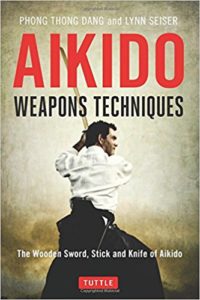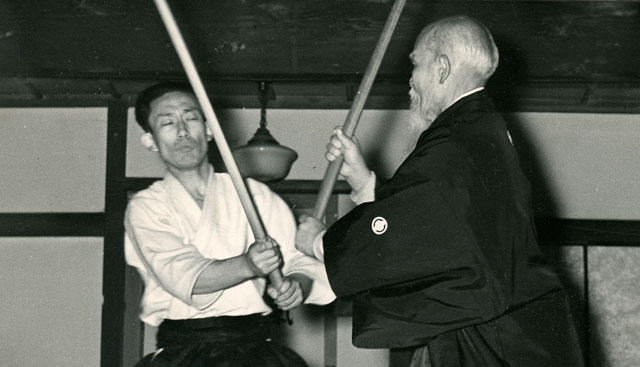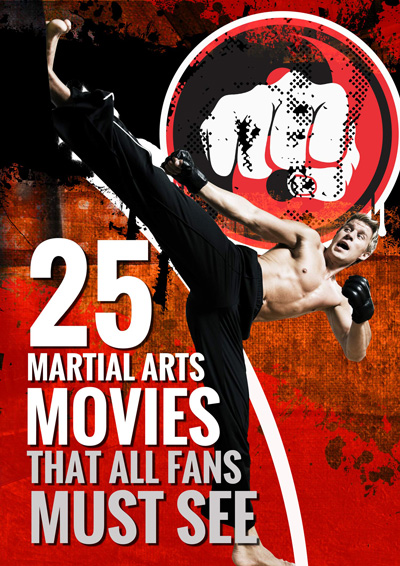 As usual, I’ve been mixing things up a little lately, I’ve got another Martial Arts Book here which revolves heavily around the weapon techniques of Aikido.
As usual, I’ve been mixing things up a little lately, I’ve got another Martial Arts Book here which revolves heavily around the weapon techniques of Aikido.
I found this book quite interesting as I studied Aikido almost ten years ago, for a solid 3 or 4 years. I‘m primarily a Muay Thai and Brazilian Jiu Jitsu guy, so I have 10+ years in those arts which are considered by many to be ‘the real deal’ and feel I have a good basis of comparison. With my background in these arts I had a little insight into what this book would be all about before reading it.
So yeah, this isn’t about martial arts movies, it’s about Aikido, which is one style a lot of martial arts film fans like to give a hard time.
Aikido has a strange visual nature and is publicly seen mostly by way of empty hand demonstrations. People see an attacker come at an Aikido practitioner with everything they have,then they seem to get sort of brushed lightly and go flipping onto the mat – it looks quite fake, but it isn’t.
Aikido is able to use redirection of force quite effectively and if you’ve ever felt a wrist lock from an authentic black belt, you know you’re jumping over your own wrist the second that sharp pain kicks in. It’s better than having a broken wrist.
But this book shows a bit more of the roots of Aikido – the weapon work.
As touched on in the book, the weapon techniques Aikido uses are translated into the open hand techniques rather directly, and once you attach a long weapon to these small movements, all of a sudden the visual mystery of Aikido is uncovered a little as the weapon reveals the movement, and you can start to understand why it’s an effective art for weapon attacks as well as grabs and overly aggressive opponents.
The first section of the book gives a very nice detailed history on the formation of Aikido, exploring not only the founder Morihei Ueshiba, but even tells the story with focus on the weapons side of things.
As Aikido is derived from a lot of sword work and samurai style movements, the style starts to make more sense to the uninformed as this book touches on those origins quite well and early.

But it’s not just about the history, it’s about the techniques.
This book quickly walks you from the history into the technical aspects of Aikido and weapon work. Even after reading this book and scanning back through, ‘Aikido Weapons Techniques’ becomes a scannable resource of training methods and is very handy to have in the martial artist’s book collection.
The book doesn’t simply show you the ‘step by steps’, but details the technical execution and sequences and surrounding factors involved with performing any of the weapons techniques.These details and techniques are covered expertly. The writer has decades of experience and worked with 6th Degree Aikido Black Belt Phong Thong Dang on the whole project.
As a martial artist who likes to refer back to techniques, the fact that it was scannable was one of its strengths for me personally.
As you flick through to find what you’re after each section is hard to miss. As each weapon has it’s own section, the photography of the weapon techniques is quite frequent, easy to follow and therefore identify.
When you see a guy holding a wooden sword, then you’ve hit the boken section. The same applies for the Jo (Wooden Staff, like a short version of a bo) and Tanto (wooden knife).
Pretty much every technique has a photo with it, which is a must for martial arts instructional books.
There’s great detail in the instructions
I’ve read many Brazilian Jiu Jitsu books before and one thing that always bugged me about a percentage of them is the lack of explanation and detail that often comes with each movement.
This book, although about Aikido, doesn’t just cover the techniques but starts by coveriung the fundamental grips, stances, draws and surrounding elements before going into the basic techniques, evolving into drills, partner drills, disarms and even maintaining control after use of the technique.
It’s not just about execution but preparation and securing your position. This book covers these aspects quite thoroughly with some having their own sections going into great detail.
Overall – it’s a handy resource for Aikido Practitioners
Sure, the weapon work in Aikido does help explain its validity in the martial arts world as it parallels it’s empty hand techniques, but this book is best served as a resource to repeatedly draw upon for existing Aikido practitioners.
If you train in Aikido, you may find it a handy book to keep on your shelf. You can find it here if you’re wanting to check it out for yourself.
Thanks for reading!



